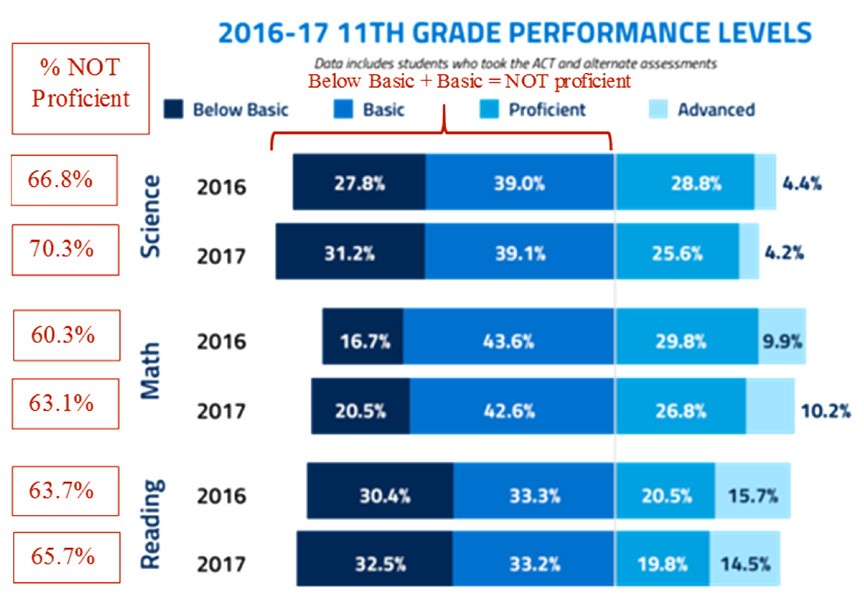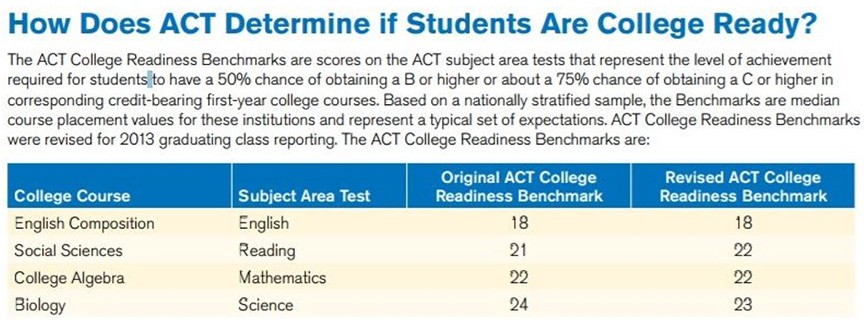What will it take to convince us our K-12 education system is not a success and needs to be held responsible for its failures? We recently got the latest 11-Grade ACT® scores from the Wyoming Department of Education (WDE). They show basically two-thirds of our kids failed to reach proficiency – just as in 2015-16.
The press release of August 16 from the Wyoming Department of Education (WDE) assures us these results were "…statistically insignificant decreases in grade 11." It does not clearly state that the proficiency results were worse in every subject or just how many of our kids are unready to enter the adult world. We hazard to guess the kids won't make it up in their senior year. See the graph below. Notes in red are by Wyoming Liberty Group.
What does it mean for kids to be below proficient on the 11th grade ACT®? It means they score below ACT®'s benchmark for the subject.
Does proficiency matter? See ACT®'s description in the graph below. Proficiency means a decent probability of earning C and B grades in college. That's a reasonable definition of being college (or career) ready and is, of course, ACT®'s entire reason for existence – estimating such potential.
In English, Wyoming's average score was slightly above benchmark in all three years. In all other subjects, scores were slightly to measurably below benchmark in all three years. (Note also there is no visible improvement over the period.)
How does this make sense? The answer is we must read results with both measurements – average score and proficiency rate - in mind. If our average overall score is near benchmark, many people would say we're doing fine. When we factor in the terrible proficiency rates, though, we realize that relying on the average score alone brings us to the inaccurate and dangerous conclusion things are ok.
For our average to be as high as it is while our proficiency is so low likely means this: we have a small number of students notching up high scores who bring up the overall average score at the same time the big majority of kids are doing poorly, bringing the proficiency rate down.
In a nutshell, measured by ACT®, way too many of our 11th graders are not college or career ready. Lack of grade-level readiness is visible, too, as measured by PAWS (grades 3-8) and NAEP (grades 4 and 8). This seems like flagrant violation of the spirit of our statute 21‑2‑204(b)(iv) Wyoming Accountability in Education Act which states a goal of our K-12 system is to, "Ensure all students leave Wyoming schools career or college ready." It seems our statute is either misguided and unachievable or our tolerance of poor public-school performance is hypocritical.
How does ACT® say high-schools will use the scores? Their website says:
"Beyond the obvious applications to academic advising and counseling, high schools use the results to:
- Evaluate the effectiveness of instruction
- Identify students who need assistance with certain subject areas or academic skills
- Plan changes and improvements in the curriculum"
One might think high-schools (and elementary and middle schools, too) will conclude their instruction is not effective, most of their students need lots of assistance and wholesale change is needed in the entire system. But will they?
Perhaps parents, too, need to conclude that they can't leave all responsibility for education to schools and that they're letting their kids get by doing much less than they need to. We hope they will.
In the WDE press release, we're conscientiously told, "This is not the time to be complacent." We most certainly agree.
What will it take for parents, taxpayers and legislators to rise up and say "enough!"


